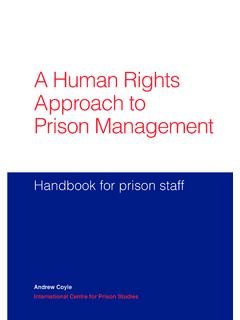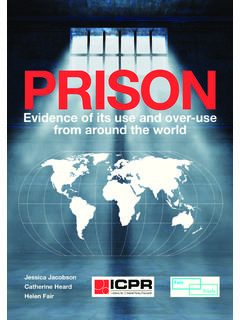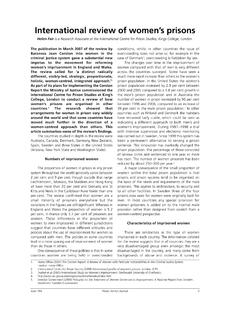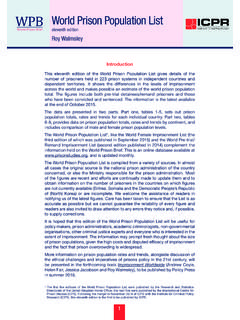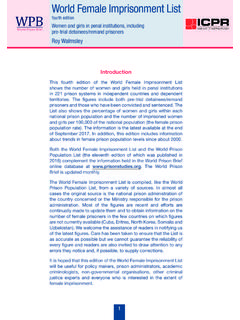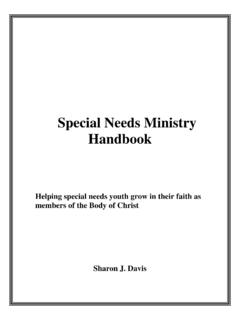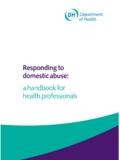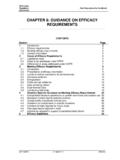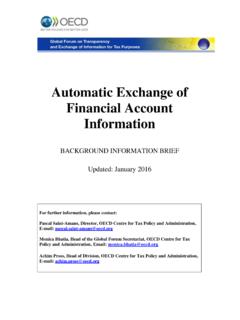Transcription of A Human Rights Approach to President nelson Mandela Prison ...
1 handbook for Prison staffSecond editionA Human Rights Approach to Prison ManagementA Human RightsApproach toPrison ManagementAndrew coyleinternational centre for Prison Studies This handbook underlines the importance of managing prisons within an ethical context which respects the humanity of everyone involved in a Prison : prisoners, Prison staff and visitors. This ethical context needs to be universal in its appeal and this universality is provided by the international Human Rights is also a pragmatic justification for this Approach to Prison management: it works. This style of management is the most effective and safest way of managing prisons. What this Approach underlines is that the concept of Human Rights is not merely another subject to be added to the training curriculum. Rather, it suffuses, and is an integral part of, good Prison 0-9545444-2-0 Secure prisons are essential to making our justice system an effective weapon against crime.
2 When prisoners convicted or awaiting trial are entrusted to your care, they must know and the public must know that they will remain there until they are legally full contribution which our prisons can make towards a permanent reduction in the country s crime-rate lies also in the way in which they treat prisoners. We cannot emphasise enough the importance of both professionalism and respect for Human nelson Mandela speaking to Prison staff in South Africa in 1998 International Centrefor Prison StudiesA Human Rights Approach to Prison ManagementHandbook for Prison StaffSECOND EDITIONA ndrew CoylePublished byInternational Centre for Prison Studies7th Floor, Melbourne House46 AldwychLondon WC2B 4 LLUnited KingdomTel: +44 (0) 20 7848 1922 Fax: +44 (0) 20 7848 1901 Email: Andrew Coyle 2009 The moral right of the authorhas been 0-9545444-2-03 PrefaceThe first edition of this handbook was published in English in 2002. Since then it has been translated into sixteen other languages.
3 * More than 70,000 copies have been printed and several of the versions are available for download from the is now used regularly by intergovernmental organisations and other international bodies in their Prison reform handbook is going to be a very useful reference tool given the prevailing Prison conditions .. in the Africa region within the Institute s programme of work.(Director, UN African Institute for the Prevention of Crime and the Treatment of Offenders)The handbook will be of utmost importance in our penitentiary activities both in San Jose in ILANUD and in countries in the region .. We will be happy to use it in our training courses and for technical assistance.(Director, UN Latin American Institute for the Prevention of Crime and the Treatment of Offenders)It is used by Prison administrations in a number of countries as a tool for developing reform strategies. Another satisfying feature of the first edition has been the manner in which it has been accepted by first line Prison staff around the world as a practical help in their daily am so impressed by the handbook that I distributed it to all correctional officers here for reference.
4 (Deputy Director, Correction Division Ministry of Justice, Seoul, Republic of Korea)The publication of this second edition of the handbook has provided the opportunity to include references to several new international and regional standards, such as the Optional Protocol to the UN Convention Against Torture, and also to refer to the increasing case law being produced by regional Human Rights courts, such as those in the Americas and in Europe. We have also taken on board the helpful comments which have been made by readers and other commentators about how we might improve the presentation of some of the chapters. One of the most important has been the request that we should have separate chapters dealing with the complete prohibition against torture and with the dignity of the prisoner as a person. In addition new chapters have been included dealing with high security prisoners and with prisoners who are non-nationals, as these are issues which have become increasingly topical in recent years.
5 * Albanian, Amharic, Arabic, Chinese, Croatian, Farsi, French, Georgian, Japanese, Korean, Portuguese, Spanish, Russian, Turkish, Serbian and Vietnamese4 AcknowledgementsMany people have contributed to this second edition of the handbook . They include all those who have commented on the first edition and who have made helpful suggestions about ICPS special mention should be made of the Associates who work tirelessly around the world for the improvement of Prison management and who have contributed indirectly or directly from their expertise and knowledge. Particular assistance was provided by Andrew Barclay, Anton Shelupanov, James Haines, Colin Allen and Alistair Stern made a major contribution to specific chapters and overall to the final Fair checked all references to the international instruments and sourced many of the case administrative support was provided by Nefeli Dardanou and Veronica Allen oversaw the entire thanks are due to all of these , the handbook could not have been published without the generous financial support of the United Kingdom Foreign & Commonwealth CoyleProfessor of Prison Studies51 Introduction page 72 The principles of good Prison management page 113 Prison staff and the administration of prisons page 154 Total prohibition of torture page 335 The dignity of the person page 396 Prisoners and health care page 477 Operating secure.
6 Safe and orderly prisons page 588 Management of high security prisoners page 719 Disciplinary procedures and punishments page 7910 Constructive activities and social reintegration page 8711 Contact with the outside world page 9912 Foreign national prisoners page 10713 Requests and complaints page 11114 Recognising diversity page 11715 Inspection procedures page 12116 Pre-trial prisoners and all others under detention without sentence page 12917 Juvenile and young prisoners page 13718 Women prisoners page 14319 Life and long term prisoners page 15120 Prisoners under sentence of death page 155 Appendix page 158 References page 161 Index page 164 Contents67 INTrODuCTIONI ntroduction1 Who the handbook is forThis handbook is intended to assist everyone who has anything to do with prisons. Readers are likely to include government ministers whose portfolio covers parliamentary accountability for prisons, officials who work within Ministries of Justice and other ministries which have oversight of Prison issues, as well as intergovernmental agencies such as the United Nations, the Organisation of American States, the African Union, the Council of Europe, the European Union, the Organisation for Security and Co-operation in Europe and the World Health Organisation.
7 It will also be of interest to bodies such as the International Committee of the Red Cross, to a variety of non governmental organisations and groups from civil society which work in prisons. It should be made available where possible to prisoners. But its primary audience is intended to be those who work directly with prisons and prisoners. These include national and regional Prison administrators. Above all, it is intended for those who are actually employed in prisons and who deal with prisoners on a day to day set of clear principlesThe topics covered in the handbook demonstrate the complexity of Prison management and the wide range of skills which are required from those whose task it is to direct prisons. The issues covered show that there is a common set of factors which, when taken together, constitute a model for good Prison management. However, it is not sufficient to consider these topics in a vacuum. It is also important that they should be grounded in a set of clear principles.
8 Since it is intended that this handbook should have application in every Prison system in the world it is essential that the set of principles which is to be used as a reference point should be applicable in every country. They should not be based on a particular culture or on the standards which are accepted in one country or region. The handbook meets this requirement by taking as its starting point for each chapter the relevant international Human Rights standardsThese standards have been agreed by the international community, usually through the United Nations. The main Human Rights instruments, such as the International Covenant on Civil and Political Rights and the International Covenant on Economic, Social and Cultural Rights , are treaties which are legally binding on all states which have ratified or acceded to them. Most of them contain references to the treatment of people who are deprived of their addition, there are a number of international instruments which deal specifically with prisoners and conditions of detention.
9 The more detailed standards which are set out in these principles, minimum rules or guidelines provide a valuable complement to the broad principles contained in the legal treaties. These include The Standard Minimum Rules for the Treatment of Prisoners (1957), The Body of Principles for the Protection of All Persons under Any Form of Detention or Imprisonment (1988), The Basic Principles for the Treatment of Prisoners (1990) and The Standard Minimum Rules for the Administration of Juvenile Justice (1985). There are also a number of instruments which refer specifically to staff working with people who have been deprived of their liberty. They include the Code of Conduct for Law Enforcement Officials (1979), the Principles of Medical Ethics relevant to the Role of Health Personnel, particularly Physicians, in the Protection of Prisoners and Detainees against Torture and Other Cruel, Inhuman or Degrading Treatment or Punishment (1982) and the Basic Principles on the Use of Force and Firearms (1990).
10 8 INTrODuCTIONR egional standardsThese international standards are supplemented by a number of regional Human Rights instruments. In Europe these are the Convention for the Protection of Human Rights and Fundamental Freedoms (1953), the European Convention for the Prevention of Torture and Inhuman or Degrading Treatment or Punishment (1989) and the European Prison Rules (1987 revised 2006). The American Convention on Human Rights entered into force in 1978, while the African Charter on Human and Peoples Rights came into force in judicial bodies are a useful reference point for measuring the extent to which individual states implement international standards. In the Americas this role is fulfilled by the Inter-American Court of Human Rights , while in Europe a similar role is carried out by the European Court of Human monitorsWithin the member states of the Council of Europe the observance of Human Rights standards in places of detention is monitored by the Committee for the Prevention of Torture and Inhuman or Degrading Treatment or Punishment, and since the first edition of this handbook its reports have become increasingly significant.
